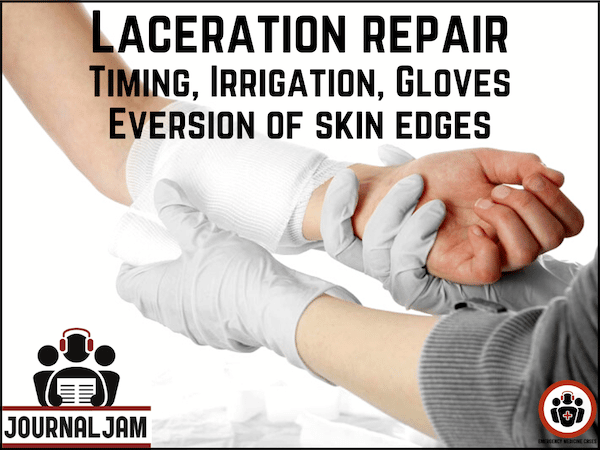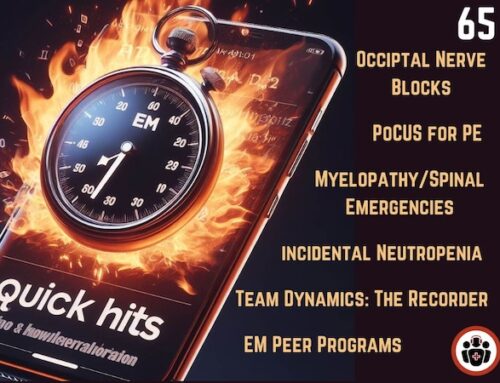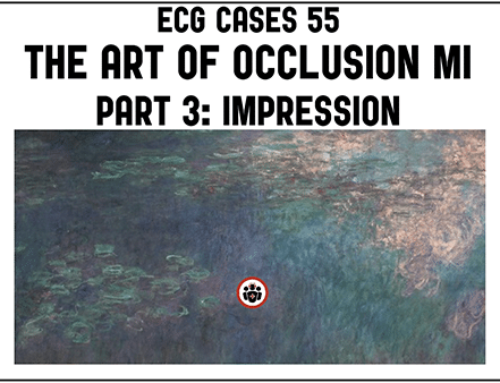There is much dogma that has been passed on from generation to generation on how we should manage lacerations in the ED. In this Journal Jam podcast Anton and Justin welcome special guest Dr. Haley Cochrane. We dive deep into the evidence for timing of closure and infection rate, fluid choice, volume and pressure of irrigation of lacerations, glove type and infection rate, how eversion of wound edges effects cosmetic outcomes and much more. You might be surprised to discover that the evidence for many things we do for lacerations that are considered “standard of care”, is either weak or non-existent. But do not fret – we deliver practical bottom line practical recommendations to help improve outcomes, save time and decrease resource utilization…
Podcast production, sound design & editing by Anton Helman
Written Summary and blog post by Anton Helman December, 2022
Cite this podcast as: Helman, A. Morgenstern, J. Cochrane, H. Journal Jam 21 Laceration Management – Does Timing of Closure, Irrigation, Glove Type, Eversion Matter?. Emergency Medicine Cases. December, 2022. https://emergencymedicinecases.com/laceration-management-timing-closure-irrigation-gloves-eversion. Accessed June 18, 2025
How late is too late for suturing lacerations? The timing of closure of lacerations
Take home points on timing of closure of lacerations:
- Whenever possible, close lacerations sooner rather than later as they are likely to heal faster with early closure.
- It is unclear from the literature if delayed closure increases infection rates or not.
- The most important management piece when it comes to delayed presentations for lacerations is counseling the patient who presents late after a laceration about what to expect with regards to healing, and taking into account cosmesis and patient preference in deciding whether or not to close the laceration.
- The usual instructions to return if signs of infection apply regardless of when the laceration is closed.
References for timing of closure of lacerations discussed in this podcast
- Eliya-Masamba MC, Banda GW. Primary closure versus delayed closure for non bite traumatic wounds within 24 hours post injury. Cochrane Database Syst Rev. 2013 Oct 22;(10):CD008574.
- Quinn JV, Polevoi SK, Kohn MA. Traumatic lacerations: what are the risks for infection and has the ‘golden period’ of laceration care disappeared? Emerg Med J. 2014 Feb;31(2):96-100.
- Hollander JE, Singer AJ, Valentine SM, Shofer FS. Risk factors for infection in patients with traumatic lacerations. Acad Emerg Med. 2001 Jul;8(7):716-20.
- Morgenstern, J. More medical dogma: The ‘golden period’ for laceration repair, First10EM, October 24, 2022. Available at:
https://doi.org/10.51684/FIRS.128601
Wound irrigation: Does it improve outcomes? Fluid type, volume and pressure
Take home points on wound irrigation
- The evidence for any real benefit of wound irrigation for lacerations is not clear.
- For visibly dirty wounds and those that were caused by a dirty implement (especially in an immunocompromised patient), irrigation makes intuitive sense and seems reasonable.
- Irrigation should not be a priority in clean-appearing wounds caused by a clean implement.
- There is no clinical evidence at all to guide us on the volume of irrigation fluid that is sufficient or necessary.
- Data on pressure is severely limited and mixed with only one positive trial.
- Based on a Cochrane Review and double blind RCT it appears that tap water irrigation of lacerations is associated with a lower infection rate compared to saline.
- There is a suggestion from older literature from the 1980’s that wound irrigation with povidone-iodine decreases infection rates after skin laceration, while there is no data on chlorhexidine; it seems reasonable to irrigate visibly highly contaminated dirty wounds or wounds caused by a very dirty implement (especially in an immunocompromised patient) with povidone-iodine solution.
References for wound irrigation discussed in this podcast
- Hollander JE, Richman PB, Werblud M, Miller T, Huggler J, Singer AJ. Irrigation in facial and scalp lacerations: does it alter outcome? Ann Emerg Med. 1998 Jan;31(1):73-7.
- Fernandez R, Griffiths R. Water for wound cleansing. Cochrane Database Syst Rev. 2012 Feb 15;(2):CD003861. doi: 10.1002/14651858.CD003861.pub3. Update in: Cochrane Database Syst Rev. 2022 Sep 14;9:CD003861.
- Ambe PC, Rombey T, Rembe JD, Dörner J, Zirngibl H, Pieper D. The role of saline irrigation prior to wound closure in the reduction of surgical site infection: a systematic review and meta-analysis. Patient Saf Surg. 2020 Dec 22;14(1):47.
- Longmire AW, Broom LA, Burch J. Wound infection following high-pressure syringe and needle irrigation. Am J Emerg Med. 1987 Mar;5(2):179-81.
- FLOW Investigators, Bhandari M, Jeray KJ, Petrisor BA, Devereaux PJ, Heels-Ansdell D, Schemitsch EH, Anglen J, Della Rocca GJ, Jones C, Kreder H, Liew S, McKay P, Papp S, Sancheti P, Sprague S, Stone TB, Sun X, Tanner SL, Tornetta P 3rd, Tufescu T, Walter S, Guyatt GH. A Trial of Wound Irrigation in the Initial Management of Open Fracture Wounds. N Engl J Med. 2015 Dec 31;373(27):2629-41.
- Weiss EA, Oldham G, Lin M, Foster T, Quinn JV. Water is a safe and effective alternative to sterile normal saline for wound irrigation prior to suturing: a prospective, double-blind, randomised, controlled clinical trial. BMJ Open. 2013 Jan 16;3(1):e001504.
- Ghafouri HB, Zare M, Bazrafshan A, Abazarian N, Ramim T. Randomized, controlled trial of povidone-iodine to reduce simple traumatic wound infections in the emergency department. Injury. 2016 Sep;47(9):1913-8.
- Gravett A, Sterner S, Clinton JE, Ruiz E. A trial of povidone-iodine in the prevention of infection in sutured lacerations. Ann Emerg Med. 1987 Feb;16(2):167-71.
- Morgenstern, J. How should we irrigate lacerations? Does it even matter?, First10EM, November 7, 2022. Available at:
https://doi.org/10.51684/FIRS.128617
Are sterile gloves necessary for laceration repair?
- About 50% of the “non-sterile” clean gloves taken from a box in an ICU were sterile, and when bacteria did grow from the gloves, none of them were significant pathogens in high enough quantity to be of concern for infection.
- Two RCTs comparing sterile gloves and “non-sterile” clean boxed gloves found no significant difference in the infection rate – 6.1-6.8 % with sterile gloves and 4.4-5.7% with clean gloves.
- Sterile gloves may be preferred for procedures that require a high degree of tactile response.
- Out-of-the-box clean gloves are acceptable for the majority of laceration repairs; consider sterile gloves for immunocompromised patients.
References for gloves in laceration repair
- Perelman VS, Francis GJ, Rutledge T, Foote J, Martino F, Dranitsaris G. Sterile versus nonsterile gloves for repair of uncomplicated lacerations in the emergency department: a randomized controlled trial. Ann Emerg Med. 2004 Mar;43(3):362-70.
- Zwaans JJM, Raven W, Rosendaal AV, Van Lieshout EMM, Van Woerden G, Patka P, Haagsma JA, Rood PPM. Non-sterile gloves and dressing versus sterile gloves, dressings and drapes for suturing of traumatic wounds in the emergency department: a non-inferiority multicentre randomised controlled trial. Emerg Med J. 2022 Jul 26:emermed-2021-211540.
- Rossoff LJ, Lam S, Hilton E, Borenstein M, Isenberg HD. Is the use of boxed gloves in an intensive care unit safe? Am J Med. 1993 Jun;94(6):602-7.
- Bodiwala GG, George TK. Surgical gloves during wound repair in the accident-and-emergency department. Lancet.1982 Jul 10;2(8289):91-2.
- Maitra AK, Adams JC. Use of sterile gloves in the management of sutured hand wounds in the A&E department.Injury.1986 May;17(3):193-5.
- Morgenstern, J. Are sterile gloves necessary when repairing lacerations in the emergency department?, First10EM, November 14, 2022. Available at: https://doi.org/10.51684/FIRS.128621
Is eversion of skin edges necessary in skin laceration repair?
- There is only one clinical trial in the dermatology literature comparing eversion of lacerated skin edges during repair to flat closure with simple interrupted sutures and there was no difference in cosmetic outcome at 3-6 months
- Perhaps more important than skin eversion is minimizing the tension on wound edges by utilizing deep sutures or mattress sutures although there is no data to support this notion
References for eversion of skin edges in laceration repair
- Kappel S, Kleinerman R, King TH, Sivamani R, Taylor S, Nguyen U, Eisen DB. Does wound eversion improve cosmetic outcome?: Results of a randomized, split-scar, comparative trial. J Am Acad Dermatol. 2015 Apr;72(4):668-73. doi: 10.1016/j.jaad.2014.11.032. Epub 2015 Jan 23.
- Morgenstern, J. Laceration repair: Does eversion matter?, First10EM, November 21, 2022. Available at:
https://doi.org/10.51684/FIRS.128610
In part 2 of this 3 part Journal Jam podcast series on laceration repair we will cover: how to decide between sutures, staples, glue and skin apposition tape as well as when absorbable sutures might be preferred over non-absorbable sutures.
Drs. Helman, Morgenstern and Cochrane have no conflicts of interest to declare.





Thoroughly enjoyed this podcast!
This is great!!! I am now converted to getting my learning from podcasts.
i am old school & never really converted till now!!
Interesting, especially tap water as a viable option. However despite lack of a lot of significant data on several of the subjects. Even with lack of data I think I’d be interesting to also have part of the podcast looking at docs getting sued for such things as not irrigating wounds/closing late etc.
So irrelevant of actual scientific data juries/ judges only know the data and nrw data cannot override opinions especially with juries.
I started in GS , switched to Anesthesia then specialized in Pediatric Anesthesia. If someone closed my wound with no gloves I’d be uncomfortable with that and you would be crucified in court.
Thank you for this podcast. I work as a NP in long-term care & supportive living. We close lacerations (glue, suture, staple) on-site to avoid transfer to ER. This podcast has definitely given me more confidence to continue this practice and encouragement to grow my skills in this area.
Thanks all. Have always utilised Australian tap water to irrigate wounds so am glad to see supporting chat about it!
On the topic of would irrigation: Justin mentions a study on open wounds and usually our orthopaedic surgeons discourage is from removing anything more than macroscopic dirt from open wounds (and especially not pressurised) as they say “…the tissue turns into tofu and is hard to operate on”. I don’t have any studies to back up this so it may be dogma , but this may be a asterics to irrigation of wounds = don’t irrigate open wounds with pressure or large amounts of water
Very nice review, amazing amount of work that you have put in to it! Looking forward for the upcoming parts even though the evidence seems very scarce.
And thanks for the quick laugh concerning the bare hands approach to ER procedures too haha
really loved the irrigation disxussion